|
12.2 - Citizens "on the move"
In 2010, European Year for Combating Poverty and Social Exclusion, the European Community highlighted the importance of "combating new sources of social inequality and building networks between individuals and communities to fight loneliness". Synergy between citizens appears to be of as fundamental importance as that between economic operators and between different sectors, especially in a period of economic recession. In this light "the system of relations and therefore also of protection" that each individual creates can be seen, which can be a network of information, culture, etc..
 Travels of Veneto residents Travels of Veneto residents
A holiday is not only a time for relaxation and freetime, necessary to find one's own space beyond everyday commitments, but also an experience by which one can discover new and different emotions, cultures, ways of life and an occasion to meet new people and make ties.
In 2007 Veneto was sixth out of all the Italian regions for the share of residents who spent a medium-long holiday in Italy or abroad. The situation in Veneto is very similar to the other northern regions, with approximately 58 holiday makers for every 100 residents. This value is 7% above the national average. The other 42% of the Veneto population do not go away even for four nights, mainly for financial reasons, followed by family reasons. The other reasons, in order of importance, are the following: because travelling is not a habit, because of work or study, health-related reasons, age, already resident in the holiday resort.
The Veneto population prefers travelling within Italy, which amounted to 78.1% of holidays in 2007. In particular Italy is the destination of 73.5% of work trips and 69.8% of stays of four nights or more, while the percentage rises even higher for short trips (91%). Those who are most inclined to travel are children with adults, with a share of over 30% of the population of Veneto, while the biggest stay-at-homes, as can be expected, are the over-sixty-fives (14.2%). The summer period sees the highest flows, concerning 55.1% of the population of Veneto.
In 2008, the most popular holiday destinations for Veneto residents in Italy were the region's holiday resorts (31.4% of arrivals), followed by those in Trentino Alto Adige (16.4%), Emilia Romagna (9.4%), and then Lombardia, Toscana, Friuli Venezia Giulia, Lazio, Marche, etc. (Figure 12.2.1).
In 2009 over one and a half million Veneto residents were tourists in Veneto, that is 11.1% of the movement of tourists in the region, a figure lower only than that for the Germans. This is a significant fact from an economic point of view, and it is even more interesting to observe the development of tourist movements in the region. In 20% of cases, stays are within the tourists' own province of residence, in the remaining 80% of cases they go beyond the boundaries of their provinces. Veneto residents generally choose their own region for seaside holidays, a choice made by more than half the holidaymakers, or for mountain holidays (20.7%), and a lower number of tourists choose to stay in its beautiful historical cities (17.9%). In fact it is not necessary to make an overnight stay to appreciate the atmosphere and unique opportunities offered by Veneto's famous historic centres. Holidays on its coast are highly popular with the residents of the province of Venezia: around 14 out of every 100 residents have spent their holidays on Veneto's beaches. Bear in mind that these figures only include those who have stayed overnight in an establishment and the numerous day trips are not considered. Residents from Verona take advantage of their own tourist destinations, especially the mountains, but also lakeside resorts, for a total of 8 out of every 100 residents (Figure 12.2.2).
Veneto residents are also following the general tendency to replace a long period of holidays with short holidays throughout the year and/or with out-of-town weekend breaks. Evidence of this over the last few years can be seen in the increase in the number of arrivals and a continuous decrease in the average length of stay both in Italian holiday destinations (there was a gradual decrease from 5.6 days in 2000 to 4.7 in 2008) and in Veneto (from 8.5 days in 2000 to 6.5 in 2009). The closest destinations are preferred, and in fact the regional tourist resorts are increasingly attractive to the residents of all the provinces, except for the Venetians. Holiday homes or hospitality in the homes of family and friends (Figure 12.2.3) and (Figure 12.2.4) are a certain alternative not revealed by the survey.
Another increasingly widespread trend over recent years concerns the choice of when to go on holiday: the peak season is naturally the most popular period, but the alternative choice of travelling during the rest of the year is attracting an increasing number of tourists, and in particular Veneto residents themselves. The fact that there is less of a distinction between the seasons indicates a tendency to save money, which is certainly more evident in a period of economic crisis.
Evidence of this tendency of Veneto residents to travel abroad, whether for work or pleasure, is revealed by a survey conducted by the Bank of Italy which provides estimates of tourist flows at the frontiers. Excluding those who do not stay overnight in an establishment because they are put up by family or friends, or because they are daytrippers (Note 1), Veneto residents appear to be more likely to travel abroad compared to other Italians, around 46 out of every 100 residents, compared to the national average of 37. When abroad, however, they spend less: around €601 on average per tourist compared with the national average of €713. This partly depends on the length of stay. For Veneto residents this is an average of 7 days compared with 8.6 days for Italians. Over recent years the average length of stay abroad has continued to drop both for Italians and for Veneto residents, but the decrease for the last year was more pronounced in the case of those from Veneto. The solution of reducing the length of the holiday makes it possible to save, but still take a holiday. The number of Italians and Veneto residents who go abroad seems to be on the increase (up around +3% compared to 2008). In general, the level of spending of Italians abroad seems to be higher compared to other periods of recession, such as those of 1975 and 1993, when GDP suffered smaller losses (Figure 12.2.5).
 The cultural aspect The cultural aspect
Culture and tourism are two closely connected sectors. Veneto's historic and artistic heritage, its vast range of cultural initiatives, and its wealth of history attract tourists here. The link is one of the main factors behind investment, which includes the promotion and development of competitiveness in regional tourism. Consequently, Regione Veneto has made a strategic choice to combine culture, hospitality, food and wine in a widespread promotional campaign abroad. This combination is due to the importance, beauty and uniqueness of the region's architecture, its monuments and museums, not to mention the growing number of cultural events organised throughout Veneto.
According to the European Union, household expenditure for cultural purposes is one of the key indicators for the evaluation of policies aimed at the long-term development of living conditions and welfare. International comparison has shown that expenditure for cultural purposes by Italian families is well below the EU27 average, which for 2006 (the last year for which figures are available for international comparison) amounted to only 6.9% of total spending, while the European average was 9.4%. Compared to the rest of Italy in 2007 Veneto ranked third, with a share of 7.8% of total expenditure. Spending on cultural products in Veneto between 2000 and 2007 increased at a higher rate than for the rest of Italy (+2% a year compared to +1.1%).
Amongst the rich and varied cultural attractions of Italy, museums play a fundamental role in the tourist economy of historic centres. In 2006 Italy had about 4,526 museums and art galleries that were not directly run by the State. Veneto, with 327 institutions, hosts about 7.2% of these. Veneto lies in fifth place for the number of establishments, but the interest shown by residents and tourists is so high that, thanks to its 7.5 million visitors, Veneto takes second place in the Italian regions after Toscana. As for State museums and galleries, Veneto's low figure of 8 institutions, 6 of which are in the province of Venezia, attracted over 800,000 visitors in 2007, 7.6% of those for Italy. Compared to the attractions on a national level, including the 40-plus UNESCO World Heritage sites, Italians' level of appreciation of cultural heritage is, however, modest compared to the rest of Europe. Italy lies in 19th place for the percentage of people aged 15 or over who visited at least one museum or exhibition in 2007, with 34% against a 41% European average. More recent data show that out of residents aged six or over, not even three out of ten people visited a museum or exhibition (28.8%) in 2009. In Veneto, thanks to the wide, prestigious range of attractions in its historic cities, the cultural choice on offer has a considerable pulling factor (33.8%).
To provide further information about residents' participation in cultural activities, some kinds of entertainment for which statistics are available for 2008 are taken into account. Cinema, the most widespread form of entertainment, both in terms of consistency and numbers, is popular in Veneto, though less so than at a national level. The number of viewings is lower (2.3 a year per 100 residents compared with 2.5), as is the number of tickets sold (179.8 per 100 residents as opposed to 185.5). In Veneto, however, theatre is more popular (46.6 admissions per 100 residents as opposed to 37.5 on a nationwide level), thanks in particular to the opera. Finally, the interest Veneto residents have for concerts is in line with the rest of Italy (Figure 12.2.6).
Let us now look at some other personal habits that are linked to recreational and cultural activities: reading of books and magazines, listening to the radio, watching television. On average 4 books are printed in Italy per inhabitant each year, but in 2009 only 45.1% of Italians read at least one book in their spare time. The willingness to read books, which in general seems low compared to other European countries, varies significantly between different areas of the Italian peninsula: in the South the share of readers is around 30%, whereas in the North it is over 50%. Veneto reaches 49.6%.
Approximately one out of two Italian citizens does not read newspapers or magazines or reads them only very occasionally. In 2009 only 56.2% of the population over 6 years of age stated that they read a daily newspaper at least once a week. In Veneto this share, at 61.1%, is higher, as it is in all the other regions of the North. Listening to the radio is about as common as reading newspapers, while watching television is among, as was to be foreseen, the habits of almost all citizens (Figure 12.2.7).
To conclude it is necessary to cite data on Internet access, which is a fundamental milestone for the social and cultural inclusion policies of the European Union. Data for 2009 show that Italy was in line with the European average when it comes to the percentage of people who have used the Internet for reading or downloading newspapers, news or magazines: 50% of Italians between the age of 16 and 74 (Note 2). This use of Internet, which can be considered as for cultural reasons, is substantially uniform across Italian regions. The use of the Internet for television and radio programmes in digital format, however, places Italy amongst less advanced countries. In 2009 in Europe 37% of people who stated that they had used the Internet in the previous quarter had used it to view television or listen to radio broadcasts. In Italy, across regions, only 29% of users accessed the Internet for these purposes.
Library networks
(Note 3) In recent years Veneto libraries have been undergoing considerable organisational change. The most obvious phenomenon of recent years, in particular from 2005 to 2009, is that of the progressive aggregation of Veneto libraries into "networks of cooperation". This phenomenon is both structural and organisational in nature, which means change that ranges from considerable to slight, and is extremely varied from area to area. In some cases some urgent Information and Communication Technology (ICT) revisions have been introduced which have given a reason, or an excuse, or the courage to bring a turnaround in the history of a particular library. This, however, has led to the realisation that it is impossible to make a fundamental choice with a "simple" change in software. In Veneto there are currently four kinds of library networks, all based on a formal agreement. These include five urban networks (including libraries of administrational authorities and different kinds of libraries in a single municipality, which in Veneto are only present in five provincial capitals); as many as ten intermunicipal networks (similar to the urban networks, but with libraries belonging to more than one municipality) depending on the year in question; seven provincial networks (of libraries belonging to the same province) and four networks (one of these is only on paper) of Italy's National Library Service (Servizio Bibliotecario Nazionale - SBN).
Note that a library can belong to all four categories of networks in the region or may decide not to join any network. The 2007 survey (Note 4) highlighted the association of libraries in networks of cooperation. In 270 municipalities, that is 46.5% of all municipalities in Veneto, at least one library was part of one network. Some were engaged in two networks (74 municipalities or 12.7% of the total), three networks (13 municipalities or 2.2%) or even four networks (3 municipalities or 0.5%). In total, then, in 2007 61.9% of Veneto municipalities had at least one library in one of the four kinds of networks of cooperation outlined above. An update of the survey carried out in April 2009 confirmed the libraries' tendency to join a network. There are 176 municipalities with no networked libraries, or 30.3% of Veneto municipalities (in 2006 there were 221, or 38% of the total). This is a noteworthy increase, especially considering that there is no library in some of these municipalities. By April 2009, 69.7% of the municipalities had at least one library belonging to a network of cooperation, a 7.8% increase on two years ago.
Why have Veneto libraries decided to join networks?
At the moment, based on experience, an attempt can be made at making an answer. Reasons may be: the need to cut library personnel numbers by outsourcing and internal mobility within the authorities; the search for economies of scale and specialisation; the use of the Internet in the daily work routine, even in the smallest libraries, thereby giving the chance to open services potentially without limits.
In this rapidly changing situation, Regione Veneto plays two fundamental roles according to those conferred by Regional Law LR no. 50 in 1984. On one hand it offers support to the networks of cooperation with the financial resources available. On the other it attempts to manage the change in terms of planning and organisation.
|
| Figure 12.2.1 |
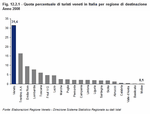 |
| Figure 12.2.2 |
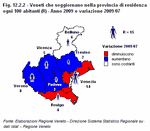 |
| Figure 12.2.3 |
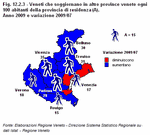 |
| Figure 12.2.4 |
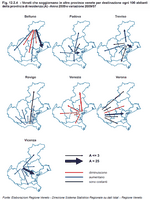 |
| Figure 12.2.5 |
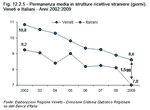 |
| Figure 12.2.6 |
 |
| Figure 12.2.7 |
 |
|
|












